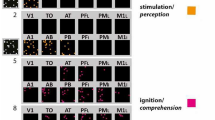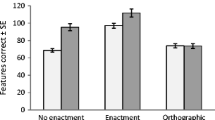Abstract.
Experimental behavioral data show that written action descriptions are remembered better when encoded by enacting them compared with merely verbal encoding. To explore this facilitating effect of encoding by performing actions ('enactment effect'), a functional magnetic resonance imaging (fMRI) study was conducted with n=18 normal subjects. During a learning condition, subjects encoded action phrases like 'cut the bread' either by reading aloud or by enacting them. The same phrases plus additional distractors were presented during fMRI scanning, and the task was to decide (yes/no key press) whether a displayed phrase was previously learned or whether it was a new one. Retrieval—independent of encoding type—activated anterior cingulate, SMA, and visual cortex bilaterally. Activations of the inferior frontal and sensorimotor cortex, and the precentral sulcus, were only left sided. The right cerebellum was also activated. The subtraction of the brain activations in the verbal condition from the enactment condition resulted in significant clusters located in middle temporal and inferior parietal left cortical areas, and, on the right side, in superior temporal, postcentral and inferior parietal cortical areas. Most striking were the bilateral inferior parietal activations, covering the supramarginal gyrus (SMG). Therefore it is concluded that SMG may be a central structure in a neurofunctional explanation of the enactment effect.

Similar content being viewed by others
References
Banich MT (1997) Neuropsychology. The neural bases of mental function. Houghton Mifflin, Boston, pp 147–148
Chaminade T, Meltzoff AN, Decety J (2002) Does the end justify the means? A PET exploration of the mechanisms involved in human imitation. Neuroimage 15:318–328
Cohen RL (1981) On the generality of some memory laws. Scand J Psychol 22:267–281
Craik FIM, Lockhart RS (1972) Levels of processing: a framework for memory research. J Verb Learn Verb Behav 11:671–684
Damasio H, Grabowski TJ, Tranel D, Ponto LLB, Hichwa RD, Damasio A (2001) Neural correlates of naming actions and of naming spatial relations. Neuroimage 13:1053–1064
Decety J, Perani D, Jeannerod M, Bettinardi V, Tadary B, Woods R, Mazziotta JC, Fazio F (1994) Mapping motor representations with positron emission tomography. Nature 317:600–602
de Jong BM, van der Graf FHCE, Paans AMJ (2001) Brain activation related to the representations of external space and body scheme in visuomotor control. Neuroimage 14:1128–1135
de Jong BM, Leenders KL, Paans AMJ (2002) Right parieto-premotor activation related to limb-independent antiphase movement. Cereb Cortex 12:1213–1217
Dolan RJ, Lane R, Chua P, Fletcher P (2000) Dissociable temporal lobe activations during emotional episodic memory retrieval. Neuroimage 11:203–209
Duffy FH, Burchfield JL (1971) Somatosensory system: organizational hierarchy from single units in monkey area 5. Science 172:273–275
Engelkamp J (1994) The human memory: a multimodal approach. Hogrefe & Huber, Seattle
Engelkamp J (1998) Memory for actions. Psychology Press, Hove, UK
Farrer C, Frith CD (2002) Experiencing oneself vs another person as being the cause of an action: the neural correlates of the experience of agency. Neuroimage 15:596–603
Frith CD, Blakemore SJ, Wolpert DM (2000) Abnormalities in the awareness and control of action. Phil Trans R Soc Lond B 355:1771–1788
Gerardin E, Sirigu A, Lehéricy S, Poline JB, Gaymard B, Marsault C, Agid Y, Le Bihan D (2000) Partially overlapping neural networks for real and imagined hand movements. Cereb Cortex 10:1093–1104
Grèzes J, Decety J (2001) Functional anatomy of execution, mental simulation, observation, and verb generation of actions: a meta-analysis. Hum Brain Mapp 12:1–19
Halsband U, Schmitt J, Weyers M, Binkowski F, Grützner G, Freund HJ (2001) Recognition and imitation of pantomimed motor acts after unilateral parietal and premotor lesions: a perspective on apraxia. Neuropsychologia 39:200–216
Heil M, Rolke B, Engelkamp J, Rösler F, Ízcan M, Hennighausen E (1999) Event-related brain potentials during recognition of ordinary and bizarre action phrases following verbal and subject-performed encoding conditions. Eur J Cogn Psychol 11:261–280
Heilman KM, Rothi LJG (1993) Apraxia. In: Heilman KM, Valenstein E (eds) Clinical neuropsychology, 3rd edn. Oxford University Press, Oxford, pp 140–163
Helstrup T (1986) Separate memory laws for recall of performed acts? Scand J Psychol 27:1–29
Helstrup T (1987) One, two, or three memories? A problem-solving approach to memory for performed acts. Acta Psychol 66:37–68
Iacoboni M, Woods RP, Brass M, Bekkering H, Mazziotta JC, Rizzolatti G (1999) Cortical mechanisms of human imitation. Science 286:2526–2528
Jeannerod M (1999) To act or not to act: perspectives on the representation of actions. Q J Exp Psychol 52A:1–29
Jones EG (1986) Connectivity of primate sensory-motor cortex. In: Jones EG, Peters A (eds) Cerebral cortex, vol 5. Plenum Press, New York, pp 113–183
Kable JW, Lease-Spellmeyer J, Chatterjee A (2002) Neural substrates of action event knowledge. J Cogn Neurosci 14:795–805
Karlsson T, Bõckman L, Herlitz A, Nilsson LG, Winblad B, Osterlind PO (1989) Memory improvement at different stages of Alzheimer's disease. Neuropsychologia 27:737–742
Kimura D (1977) Acquisition of a motor skill after left hemisphere damage. Brain 100:527–542
Knopf M (1992a) The age decline in memory: can it be eliminated? In: Fabris N, Harman D, Knook DL, Steinhagen-Thiessen E, Zs-Nagy I (eds) Physiopathological processes of aging. New York Academy of Sciences, New York, pp 172–179
Knopf M (1992b) Gedächtnis für Handlungen [Memory for actions]. Universität Heidelberg, Heidelberg
Kolb B, Whishaw IQ (1993) Neuropsychologie. Spektrum Akademischer Verlag, Berlin, pp 218–220
Lezak M (1995) Neuropsychological assessment, 3rd edn. Oxford University Press, Oxford, pp 74–81
Maquet P, Peters JM, Aerts J, Delfiore G, Degueldre C, Luxen A, Franck G (1996) Functional neuroanatomy of human rapid-eye-movement sleep and dreaming. Nature 383:163–166
Martin A, Haxby JV, Lalonde FM, Wiggs CL, Ungerleider LG (1995) Discrete cortical regions associated with knowledge of color and knowledge of action. Science 270:102–105
Moll J, de Oliveira-Souza R, Passman LJ, Cunha FC, Souza-Lima F, Andreiuolo PA (2000) Functional MRI correlates of real and imagined tool-use pantomimes. Neurology 54:1331–1336
Mountcastle VB, Lynch JC, Georgopoulos A, Sakata H, Acuna C (1975) Posterior parietal association cortex of the monkey: command functions for operation within extrapersonal space. J Neurophysiol 38:871–908
Nilsson LG (2000) Remembering actions and words. In: Tulving E, Craik FIM (eds) The Oxford handbook of memory. Oxford University Press, Oxford, pp 137–148
Nilsson LG, Nyberg L, Klingberg T, Aberg C, Persson J, Roland E (2000) Activity in motor areas while remembering action events. Neuroreport 11:2199–2201
Nyberg L, Petersson KM, Nilsson LG, Sandblom J, Åberg C, Ingvar M (2001) Reactivation of motor brain areas during explicit memory for actions. Neuroimage 14:512–528
Roland PE (1993) Brain activation. Wiley-Liss, New York, pp 389–392
Rushworth MFS, Nixon PD, Renowden S, Wade DT, Passingham RE (1997) The left parietal cortex and motor attention. Neuropsychologia 35:1261–1273
Rushworth MFS, Krams M, Passingham RE (2001) The attentional role of the left parietal cortex: the distinct lateralization and localization of motor attention in the human brain. J Cogn Neurosci 13:698–710
Russ MO, Knorr U, Lanfermann H, Kleinschmidt A (2001) Cerebral correlates of verbally vs visuospatially instructed response selection. Neuroimage 13:1246
Sirigu A, Duhamel JR, Cohen L, Pillon B, Dubois B, Agid Y (1996) The mental representation of hand movements after parietal cortex damage. Science 273:1564–1568
Stephan KM, Fink GR, Passingham RE, Silbersweig D, Ceballos-Baumann AO, Frith CD, Frackowiak RSJ (1995) Functional anatomy of the mental representation of upper extremity movements in healthy subjects. J Neurophysiol 73:373–386
Tranel D, Damasio H, Damasio AR (1997) A neural basis for the retrieval of conceptual knowledge. Neuropsychologia 35:1319–1327
Tranel D, Adolphs R, Damasio H, Damasio AR (2001) A neural basis for the retrieval of words for actions. Cognit Neuropsychol 18:655–670
Author information
Authors and Affiliations
Corresponding author
Rights and permissions
About this article
Cite this article
Russ, M.O., Mack, W., Grama, CR. et al. Enactment effect in memory: evidence concerning the function of the supramarginal gyrus. Exp Brain Res 149, 497–504 (2003). https://doi.org/10.1007/s00221-003-1398-4
Received:
Accepted:
Published:
Issue Date:
DOI: https://doi.org/10.1007/s00221-003-1398-4




